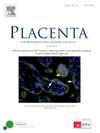妊娠期感染COVID-19的妇女胎盘DNA损伤/修复反应增加
IF 3
2区 医学
Q2 DEVELOPMENTAL BIOLOGY
引用次数: 0
摘要
sars - cov -2可诱导受感染细胞的DNA损伤。该研究的目的是确定母体COVID-19感染是否会诱导胎盘细胞DNA损伤。我们检测了怀孕期间感染或未感染COVID-19的妇女胎盘标本中磷酸化组蛋白H2AX (pH2AX)的局灶阳性细胞、MRE11的表达和端粒长度(DNA损伤/修复的标志物)。方法采用61例胎盘福尔马林固定石蜡包埋(FFPE)组织标本,其中新冠肺炎组33例,对照组28例。免疫染色法检测pH2AX (Ser-139)和MRE11的表达。使用相对人端粒长度定量qPCR检测试剂盒评估端粒长度。通过电子病历审查获得产妇人口统计数据。数据分析采用非配对t检验或卡方检验。p水平<;0.05有统计学意义。结果新冠肺炎组胎盘中sph2ax病灶阳性细胞显著高于对照组,p <;0.01;MRE11的相对表达量在COVID组(15.68±1.57)显著高于对照组(5.74±1.21),p <;0.01. 冠状病毒感染组相对端粒长度(0.839±0.123)明显短于对照组(1.652±0.285),p <;0.05. 还分析了端粒长度与胎盘重量、分娩胎龄及胎盘/新生儿比的相关性。结论pH2AX和MRE11都是DNA双链断裂的生物标志物。端粒是持续DNA损伤反应的目标,端粒长度减少是细胞衰老和衰老的一个指标。我们发现妊娠期感染COVID-19的妇女胎盘细胞中pH2AX灶阳性细胞和MRE11表达增加,端粒长度减少,这为胎盘细胞DNA损伤增加可能与妊娠期母体COVID-19感染相关提供了可信的证据。本文章由计算机程序翻译,如有差异,请以英文原文为准。
Increased DNA damage/repair response in placentas from women infected with COVID-19 in pregnancy
Introduction
SARS-CoV-2 may induce DNA damage in infected cells. The objective of the study is to determine if maternal COVID-19 infection can induce cellular DNA damage in the placenta. We examined phospho-Histone H2AX (pH2AX) foci-positive cells, MRE11 expression, and telomere length (markers of DNA damage/repair) in placental specimens from women with or without COVID-19 infection during pregnancy.
Methods
A total of 61 placental formalin-fixed paraffin embedded (FFPE) tissue specimens were used in the study, 33 in the COVID-19 group and 28 in the control group. Expression of pH2AX (Ser-139) and MRE11 was determined by immunostaining. Telomere length was assessed using the relative Human Telomere Length Quantification qPCR Assay Kit. Maternal demographic data was obtained via electronic medical record review. Data were analyzed by unpaired t-test or Chi-square test. A p level <0.05 was set statistically significant.
Results
pH2AX foci-positive cells in the placentas were significantly higher in the COVID group than in the control group, p < 0.01; Relative expression of MRE11 was significantly increased in the COVID group (15.68 ± 1.57) than in the control group (5.74 ± 1.21), p < 0.01. In contrast, relative telomere length was significantly shorter in the COVID group (0.839 ± 0.123) than in the control group (1.652 ± 0.285), p < 0.05. The correlation of telomere length with placental weight and gestational age at delivery and the correlation of placental/newborn ratio were also analyzed.
Conclusions
Both pH2AX and MRE11 are biomarkers of DNA double-strand breaks. Telomeres are targets of a persistent DNA damage response, and reduced telomere length is an indicator of cellular senescence and aging. Our findings of increased pH2AX foci-positive cells and MRE11 expression and reduced telomere length in placental cells from women infected with COVID-19 in pregnancy provide plausible evidence that increased placental cellular DNA damage could be associated with maternal COVID-19 infection in pregnancy.
求助全文
通过发布文献求助,成功后即可免费获取论文全文。
去求助
来源期刊

Placenta
医学-发育生物学
CiteScore
6.30
自引率
10.50%
发文量
391
审稿时长
78 days
期刊介绍:
Placenta publishes high-quality original articles and invited topical reviews on all aspects of human and animal placentation, and the interactions between the mother, the placenta and fetal development. Topics covered include evolution, development, genetics and epigenetics, stem cells, metabolism, transport, immunology, pathology, pharmacology, cell and molecular biology, and developmental programming. The Editors welcome studies on implantation and the endometrium, comparative placentation, the uterine and umbilical circulations, the relationship between fetal and placental development, clinical aspects of altered placental development or function, the placental membranes, the influence of paternal factors on placental development or function, and the assessment of biomarkers of placental disorders.
 求助内容:
求助内容: 应助结果提醒方式:
应助结果提醒方式:


